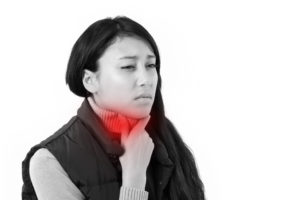New Targeted Treatments for Asthma
 Asthma is a chronic inflammatory disorder of the lungs. Genetics play a major role in the causation of the disease process. It is a characteristically variable disease with the severity varying from person to person. It also varies at different stages in one’s lifetime of an affected individual. Environmental factors such as exposure to allergens, irritants, and infections are the usual factors that trigger exacerbations of asthma.
Asthma is a chronic inflammatory disorder of the lungs. Genetics play a major role in the causation of the disease process. It is a characteristically variable disease with the severity varying from person to person. It also varies at different stages in one’s lifetime of an affected individual. Environmental factors such as exposure to allergens, irritants, and infections are the usual factors that trigger exacerbations of asthma.
Even when symptoms are not present, low-grade inflammation is believed to exist in affected individuals. In patients who are susceptible to frequent flare-ups of asthma, it has been well established that adequately controlling the ongoing inflammation will substantially reduce the frequency and severity of exacerbations. Uncontrolled inflammation can also adversely affect the lung function in the long term.
Corticosteroids are global anti-inflammatory agents and have been the mainstay of maintenance therapy for several decades. They are proven to suppress the inflammatory cascade at multiple points in a dose-dependent fashion. They are very reliable in preventing flare-ups of asthma as well as preserving lung function. However, long-term use of corticosteroids (especially in high doses) unfortunately is not without risks. The potential side effects may include increased susceptibility to infections, thinning of bones, cataracts, glaucoma, increased appetite, weight gain, mood swings, glucose intolerance as well as many other adverse effects. These side effects can be minimized by using these agents in the lowest effective dosage and for the shortest possible time.
Over the past several years, scientists have focused on developing alternatives to corticosteroids with fewer side effects. Research has been fruitful in delineating various “pathways” in the causation and progression of inflammation. Different chemical mediators mediate the process at different stages. Blocking these mediators by specific drugs has proven to be effective in controlling the resulting inflammatory damage to tissues.
Leukotrienes were one of the earliest identified mediators for which blocking drugs were developed. Zileuton (i.e., Zyflo), zafirlukast (i.e., Accolate) and montelukast (i.e., Singulair) were approved by the U.S. Food & Drug Administration (i.e., FDA) for maintenance treatment of asthma in the late 1990’s. These are oral medications used daily in patients with persistent asthma. Zyflo works by inhibiting leukotriene formation whereas both Accolate and Singulair block the action of specific leukotrienes. Though these drugs do not help everyone, they are very effective in asthmatics in which leukotrienes play a major role in perpetuating inflammation. These agents do not have the steroid related side effects, however, a very small percentage of people using Singulair were noted to experience emotional disturbances such as depression. In addition, patients taking Zyflo must have their liver function tests monitored while on the medication.
Immunoglobulin E (i.e., IgE) is the antibody that mediates allergic reactions and contributes to the disease frequency and severity of asthma exacerbations. Omalizumab (i.e., Xolair) is a monoclonal antibody that depletes IgE in the blood and has been shown to reduce the frequency of symptoms and exacerbations in patients with asthma. Note that it is also helpful in the treatment of recalcitrant chronic idiopathic urticaria (i.e., hives). For asthma, it is given as an injection under the skin (i.e., subcutaneously) at a dose of 75 to 375 mg. every 2 or 4 weeks to patients 6 years of age and older. The dose is calculated based on the serum IgE level and the weight of the patient and is given to patients with moderate to severe persistent asthma. This medication is however unlikely to be helpful in patients with non-allergic asthma. In the treatment of chronic idiopathic urticarial, Xolair is given subcutaneously at a dose of 150 or 300 mg. every 4 weeks to patients 12 years of age and older and is not dependent on the serum IgE level or body weight.
Eosinophils, on the other hand, are a type of white blood cell, long known to cause tissue damage when present in excessive numbers. In a subtype of asthma, these cells play a predominant role in the inflammatory pathway. Three “biological” medications were recently approved by the FDA for maintenance treatment of “eosinophilic” asthma. These medications are effective in controlling asthma in patients who have high levels of eosinophils in their peripheral blood, detected in a commonly done test called a CBC (i.e., complete blood count).
Mepolizumab (i.e., Nucala) was approved in November of 2015. It is a monoclonal antibody that blocks a molecule called IL-5 (i.e., interleukin-5) which is essential for growth and survival of eosinophils. It is given as a subcutaneous injection at a fixed dose of 100 mg. every 4 weeks in patients 12 years of age and older who have severe persistent asthma.
Reslizumab (i.e., Cinqair) is another monoclonal antibody that received FDA approval in March of 2016. This medication is administered intravenously in a dose of 3mg. per kg. of body weight, every 4 weeks, infused over 20 to 50 minutes for patients with severe persistent asthma aged 18 years and older.
The most recent medication receiving approval for maintenance treatment of severe persistent asthma was benralizumab (i.e., Fasenra). It was approved in November of 2017 for patients 12 years of age and older with the eosinophilic asthma phenotype. It is injected subcutaneously in a fixed dose of 30 mg. The frequency of administration is once every 4 weeks for the first 3 doses and then once every 8 weeks thereafter.
The board certified allergy doctors at Black & Kletz Allergy have 3 convenient locations with on-site parking located in Washington, DC, McLean, VA (Tysons Corner, VA), and Manassas, VA. The Washington, DC and McLean, VA offices are Metro accessible and we offer a free shuttle that runs between the McLean, VA office and the Spring Hill metro station on the silver line. The allergists at Black & Kletz Allergy are extremely knowledgeable about the most current treatment options for patients with asthma and related disorders and can promptly answer any of your questions. To schedule an appointment, please call any of our offices or you may click Request an Appointment and we will respond within 24 hours by the next business day. We have been servicing the greater Washington, DC area for more than 50 years and we look forward to providing you with excellent state of the art allergy and asthma care in a friendly and pleasant environment.

 It is that time of the year again when families and friends gather together for the highly anticipated Thanksgiving Day holiday. Most people do not think about how Thanksgiving may affect one’s allergies, however, the holiday is full of potential triggers for many individuals prone to various allergies.
It is that time of the year again when families and friends gather together for the highly anticipated Thanksgiving Day holiday. Most people do not think about how Thanksgiving may affect one’s allergies, however, the holiday is full of potential triggers for many individuals prone to various allergies. Adverse reactions to medications are very common. Among the drugs associated with immediate hypersensitivity reactions (i.e., Type I allergy, IgE antibody-mediated allergy), penicillins are the most commonly observed.
Adverse reactions to medications are very common. Among the drugs associated with immediate hypersensitivity reactions (i.e., Type I allergy, IgE antibody-mediated allergy), penicillins are the most commonly observed. “Flu” season is almost here and it is time to get prepared for its onslaught.
“Flu” season is almost here and it is time to get prepared for its onslaught. Halloween is just around the corner and most individuals do not think of allergies when thinking of Halloween. They more aptly think of costumes, trick-or-treating, candy, bobbing for apples, skeletons and skulls, and Halloween parties. It is a festive time of the year and both adults and children enjoy the holiday. Even though adults enjoy the event, it is the children that really become excited!
Halloween is just around the corner and most individuals do not think of allergies when thinking of Halloween. They more aptly think of costumes, trick-or-treating, candy, bobbing for apples, skeletons and skulls, and Halloween parties. It is a festive time of the year and both adults and children enjoy the holiday. Even though adults enjoy the event, it is the children that really become excited! The most common type of food allergy is an “immediate hypersensitivity” reaction (i.e., Type I reaction), where the symptoms usually begin within a few minutes of exposure to the offending food. These reactions are mediated by an antibody called IgE which interacts with the protein (i.e., antigen, allergen) in the food. This interaction causes a release of chemicals which are responsible for the undesirable allergic symptoms. The most common foods that cause these types of reactions are nuts and shellfish, though any food can theoretically trigger IgE.
The most common type of food allergy is an “immediate hypersensitivity” reaction (i.e., Type I reaction), where the symptoms usually begin within a few minutes of exposure to the offending food. These reactions are mediated by an antibody called IgE which interacts with the protein (i.e., antigen, allergen) in the food. This interaction causes a release of chemicals which are responsible for the undesirable allergic symptoms. The most common foods that cause these types of reactions are nuts and shellfish, though any food can theoretically trigger IgE. Recurrent infections occur in many individuals in the U.S., as well as around the world. In the U.S., malnutrition is not a common cause as it is in many undeveloped third-world countries. Parasitic infections are also not very common in the U.S. unless an individual travels to a developing country, consumes uncooked meat/fish, drinks tainted water, or has an immune deficiency. The most common types of infections found in the U.S. are numerous and include
Recurrent infections occur in many individuals in the U.S., as well as around the world. In the U.S., malnutrition is not a common cause as it is in many undeveloped third-world countries. Parasitic infections are also not very common in the U.S. unless an individual travels to a developing country, consumes uncooked meat/fish, drinks tainted water, or has an immune deficiency. The most common types of infections found in the U.S. are numerous and include  Definition:
Definition: